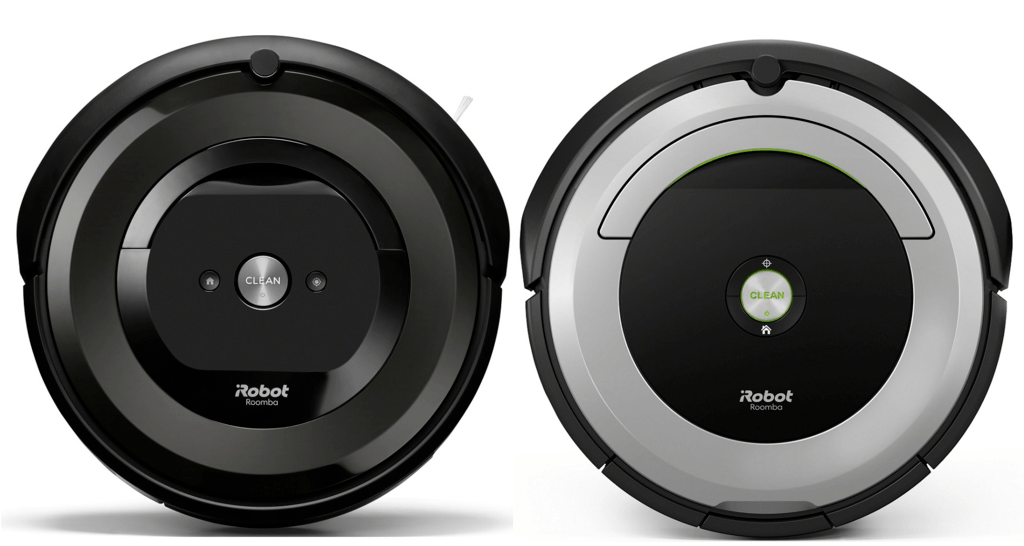Economy class, budget-friendly, entry-level robot; all of these terms usually mean one thing: a cheaply built, under-performing robotic vacuum. Sure, they save you money, but the results are usually less than stellar; until you add the Roomba name to the mix. Instead of “cheap,” you get inexpensive. The Roomba e5 and 690 are two such examples.
Sure, the Roomba e5 may cost a little more than your average entry-level robot, but it outperforms almost all of them. The Roomba 690, on the other hand, is seeing yet another price drop due to the release of the e5.
Which one is the best deal for you? I will answer that question in this article. While I uncover the details and secrets behind each machine and give you a side-by-side comparison of both models. Continue on to the main article to learn all there is to know about the two machines.
If you are in a hurry though, I would pick up the Roomba e5 over the Roomba 690.
Contents
The Differences between Roomba e5 and 690
The two robots are going to have a few differences. They are four generations apart. Let’s see what those differences are.
- Bristle brush extractors are used by the 690 whereas the e5 has brushless rollers. (Brushless rollers are much easier to maintain.)
- The collection bin of the e5 is larger than the bin of the 690.
- High-efficiency, HEPA quality filters are used in the e5 model, but not in the 690 model.
- The e5 cleans better than the 690.
The Similarities between these Two Vacuums
There will also be things that just work, regardless of how old or new the technology is. These things will remain from model to model, simply because they work so well.
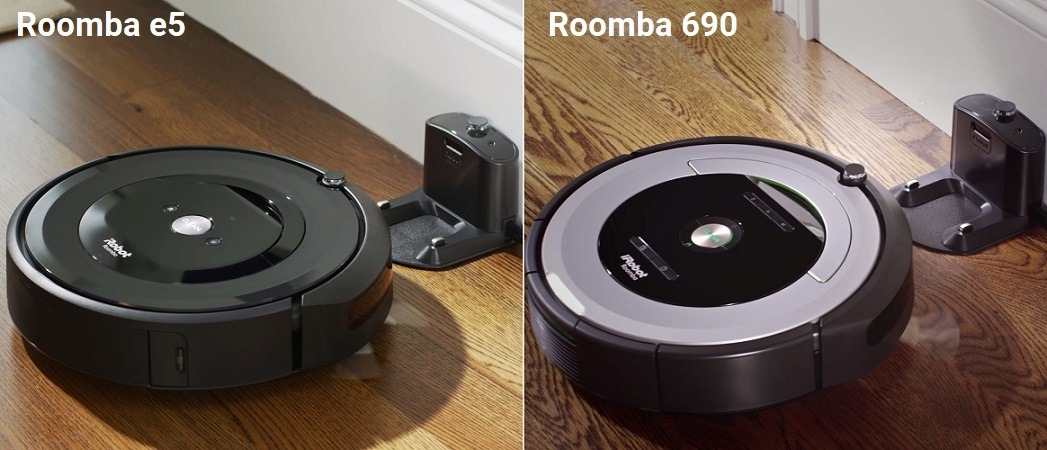
- The virtual wall barriers are the go-to containment method for both robots.
- The 690 and the e5 will both connect to your home network so you can use the mobile app for control.
- You can also use your voice to control the Roomba e5 and 690 through Amazon Alexa and Google Assistant enabled devices.
- When the battery level drops below 15 percent, both the Roomba 690 and e5 will return to the charging dock automatically. (They won’t resume where they left off though.)
- Both models use the same suite of sensors for navigation, including the drop, bump and dirt detection sensors.
Specifications Chart
Here is a look at the two machines in a side by side comparison chart to see what they do and do not offer.
| Roomba 690 | Roomba e5 | |
| Size | 13x13x3.6 inches | 13.3×13.3×3.6 inches |
| Weight | 7.72 pounds | 7.2 pounds |
| Navigation | pseudo-random | pseudo-random |
| Battery | 1800mAh lithium-ion | 1800mAh lithium-ion |
| Runtime | Up to 60 minutes | Up to 90 minutes |
| Charge Time | 2 hours | 3 hours |
| Automatic Recharge | Yes | Yes |
| Entire Level Clean | No | No |
| Filter | AeroVac Standard | High-efficiency |
| Carpet Boost | No | Yes |
| Drop Sensors | Yes | Yes |
| Bump Sensors | Yes | Yes |
| Dirt Detection Sensors | Yes | Yes |
| Camera Navigation | No | No |
| Wireless Communications | Yes | Yes |
| Mobile App | Yes | Yes |
| Voice Controls | Yes | Yes |
| Floor Types | All | All |
| Washable Collection Bin | No | Yes |
| Side Brushes | 1 Side Brush | 1 Side Brush |
| Containment | Dual Mode Virtual Wall Barrier | Dual Mode Virtual Wall Barrier |
| Warranty | 1 year | 1 year |
| Price | Check on Amazon | Check on Amazon |
Comparing the e5 and 690 in Detail
Now we get to the juicy details. I will pick apart and explain some of the more prominent features from both machines and you can decide for yourself which one wins.
The Batteries
One of the first things you may notice about these two models is the runtime that each one has. The runtime is an estimation of how long the robot will run before the battery dies. This number can be a bit misleading. Allow me to explain.
The robots are capable of cleaning all floor types, both hard flooring and carpet. When the lab tests the robots for their longevity they go through a series of tests. One of the tests is to put debris all over the floor and let the robots clean until their batteries die.
When they have run the test a few times, they take the highest average and tout that as the expected runtime.
What they don’t tell you is that there are a few flaws to the test. First, the test is only run on hard flooring. In fact, if you look at the tiny print, even the iRobot website will state the tests are run on floors without carpet.
This is mainly due to how hard the robots work when cleaning carpeted floors. The motors work harder and faster and the extractors spin faster, all of which cause more battery drain.
The other thing they won’t tell you is that they don’t allow the robot to dock. So that final 15 percent of battery life goes into the overall time. However, when you get the robot home, it will dock before the battery is completely drained, which takes away from the overall time it is actually cleaning your floors.
The Roomba 690 has a Short Runtime
When you see that the 690 has a runtime of up to 60 minutes, you may think to yourself, “hey, it only takes me 20 minutes to vacuum my house, an hour should be plenty.” In most cases, you will probably be correct.
However, because the Roomba 690 has a small 1800mAh battery pack, a lack of mapping abilities and no clear indication of where it is going, it may fall short. The idea is to count the number of rooms you are going to have the robot clean. Living room, dining room, bedrooms, etc.
On average, the Roomba 690 will take about 22 minutes to clean a single room. This means, even with the full 60 minutes of cleaning, you are only going to get about three rooms cleaned.
Again, this is a tad misleading. The robot will run around the entire home going back and forth, in one room, out another and back again. The robot will cover about 1400 to 1600 square feet of floor space while it is running on that charge.
This may or may not be enough to cover your entire home. If not, you will need to restart a cleaning cycle after the robot has recharged its battery. The easier thing to do is to just schedule daily cleanings and let the robot roam where it desires on any particular day. Over time, all surfaces will be cleaned just by chance alone.
Roomba e5 has a 50% Longer Runtime
The 1800mAh battery on the Roomba e5 touts a runtime of up to 90 minutes. Same as before, though, you can expect less in actual use. However, the extra runtime is a bit closer to actual than the 690 has. This is because of the efficiency built in with the new technology.
This translates to one thing for you: a more efficient clean with better time management for the battery. On average, the e5 only takes between 16 and 19 minutes to clean a single room.
The e5 will be able to cover about 1600 to 1800 square feet on a single charge. Of course, as always this number will drop depending on the layout of the floor space and the amount of carpeting involved.
While it won’t be the most stylish cleaning cycle, it will get the job done.
Bottom Line: The Roomba e5 wins. A larger battery and longer runtime are easy wins for the robot.
While batteries are important, a solid navigation technology is just as crucial. Without navigation and sensors, the robots wouldn’t be very good vacuums.
iRobot uses a technology they created called iAdapt. This is a combination of sensors working with computer algorithms to understand the size of your home without the need for mapping. Using this technology, the robots will know where to go and use a pseudo-random method of cleaning the floors.
In later versions of the iAdapt software, mapping was included. The robots began using cameras in the 900 series to take photos of the floor space and surrounding areas. The software then combined these images to create a map of your home that the robot could follow.
To save money in production (and thus a lower cost for you), not every model uses the mapping technology. The Roomba 690 and e5 do not have mapping capabilities. Instead, they rely on the old-fashioned sensor-based navigation techniques.
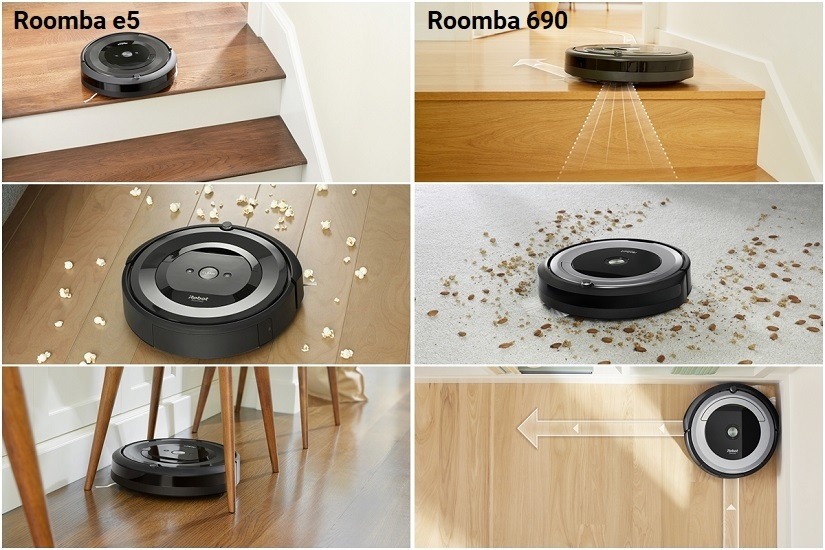
Bottom Line: A Tie. Both navigate without cameras, in a random pattern.
The Control Options are Very Similar
When it comes to controlling your robots you have three options: local controls on the machine itself, the iRobot Home mobile app, or Voice commands through Amazon Alexa and Google Assistant enabled devices.
The local controls are the same for both the 690 and the e5. You will have three buttons: Clean, Home and Spot.
Clean is the primary and largest button on the faceplate. Pressing it once will wake the robot while pressing a second time will send the robot off to do a default clean using the automatic cleaning cycle.
If you press it a third time, the robot will pause the cleaning cycle. This will enable you to press another button, or press it a fourth time to resume cleaning.
The Home button will send the robot back to the charging station. This will cancel the cleaning cycle it is currently completing and you will have to manually restart the cycle later by pressing the Clean button again.
You will have to pause the cleaning cycle before the Home button will send the robot to the Home Base.
The Spot button will tell the robot to perform a spot clean in the area it is currently in. You can either pick the robot up (there is a handle) and transport it manually to the area that needs dedicated attention, or let it get there on its own, pause the cleaning cycle and perform a spot clean.
Either method you choose will make the robot clean the area using a spiraling motion that extends outward about three feet from where it is when you press the button. Once the cycle is complete, the robot will return to the Home Base to recharge and await further instructions.
The Mobile App is the Preferred Method of Control for Most People
The iRobot Home app is used to control the robot using your mobile phone or tablet. With the app, you can perform any action the robot is capable of.
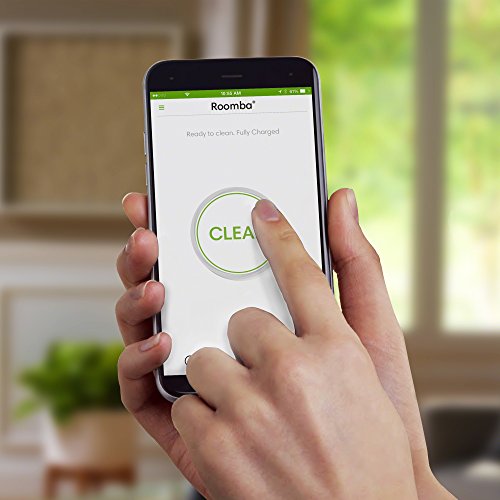
You can nickname your robot, which comes in handy if you have multiple models. You can create, edit and delete scheduled cleanings, and perform all of the cleaning modes the robot is able to perform.
You will also be able to see the status of your robot and know, at a glance, if it is cleaning, charging or doing nothing. You will also be able to see the battery level and know when you should replace the filter and side brushes.
The beauty of the mobile app is that you don’t have to be near the robot (or even in the house) to use it. You can start a cleaning cycle while you are out shopping or in the office.
Using Bluetooth connections, you will also be able to update the firmware and software for the robot directly from the app if there is a newer version. Of course, you will need to be near the robot to do this function.
The Voice Commands Keep Growing
The third and final form of control is the voice commands. You can use your voice to control the robot through Amazon Alexa and Google Assistant enabled devices. You will also be able to integrate these controls through SmartThings, Wink, IFTTT and others.
The voice commands aren’t as limited as they used to be. Now you can start, stop, pause and resume a cleaning cycle as well as send the robot to the Home Base for a recharge of the batteries.
Now, however, you can do even more. You will be able to find the robot in the home and figure out the status of the robot. You will also be able to create or cancel a scheduled cleaning and determine if there is a schedule already.
As the technology continues to evolve, new voice commands are added. There may even come the point when voice commands can be given directly to the robot without the need for third-party devices.
Bottom Line: This round is a tie. Both robots use the same methods of control.
Filtration and Debris Extraction Are Polar Opposites
One of the major debates is how good the filtration needs to be on these machines. One side of the coin says that HEPA quality filtration is a must. If you suffer allergies, you need to have a filter that removes the allergen causing microbes from your home.
The other side says that you still have to use an upright vacuum to clean your floors and those should be the HEPA filtered units as they do a more thorough and deeper clean.
Whichever side you are on may be the difference maker in your decision between these two robots.
The Roomba e5 has a high-efficiency filter. It is HEPA quality, though not HEPA certified. It’s just a label, though, so don’t worry too much. The high-efficiency filters collect all particles down to three microns in size. This is efficient enough to capture pollen, molds, dust mites and pet dander.
Allergy sufferers will want the e5 over the 690 because of the high-efficiency filtration.
If, however, you are on the other side of the coin, the Roomba 690 may suit you just fine. The 690 uses the AeroVac Standard filter. It will only collect particles down to 10 microns in size. This is sufficient enough to keep the motor area clean of debris but not capture allergy causing items.
Keeping the motor free from dust build up is the primary function of a filter on a vacuum. Without it, the motor would get coated in dust and eventually overheat or break down.
Having the filter also capture allergens is a secondary function that many people (especially those looking to save more money) have decided they can live without.
The Roomba e5’s Brushless Rollers Are Much Easier to Maintain
When it comes to cleaning your floors, there are now two different extraction methods. Bristle brushes or brushless rubber extractors. Your floor types may have more to play in this decision than your personal preference.
The Roomba 690 uses dual rotating bristle brush rollers. They are soft bristles so they don’t scratch most surfaces (softwoods like pine may still need to be watched), they also don’t do as great a job agitating the carpet fibers to get a deeper clean.
If your home is primarily hard flooring, it may not matter to you. The brush rolls still do a wonderful job sweeping and cleaning hard flooring without any problems. They will also keep low and medium pile carpeting clean between your regular chore days to be a real help.
High pile carpet may cause more problems, so you will need to keep an eye on the robot for the first few cleaning rounds.
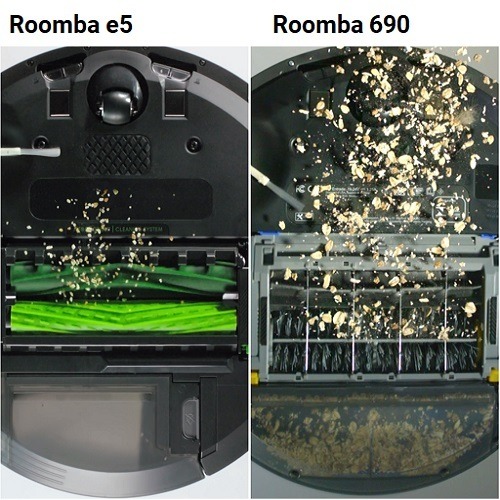
The Roomba e5, on the other hand, has brushless extractors. These dual rotating bars use rubber blades to loosen, lift, sweep and collect the particles. They won’t scratch any surface, so all of your hard floorings is safe.
On carpet, they also work well to agitate deep into the carpet fibers to loosen and lift debris just like your upright (though not as powerful). They are also easier to maintain. While both robots have easy access to the removal and cleaning of the rollers, the e5’s brushless rollers wipe off easily, even long hair and string that can get wrapped.
The bristle brush rollers of the 690 will give you more frustration, just like cleaning off your upright rollers. You may find yourself using scissors to aid in the removal of tangled hair, strings and carpet fibers.
Bottom Line: The Roomba e5 wins. Better cleaning, easier maintenance and less possible damage to flooring is a win in my book.
Frequently Asked Questions
I will quickly answer a few of the most common questions regarding the two robots. If you need more answers, please feel free to use the comments section below the article.
Q. I hear the e5 has a different dustbin, is this correct?
A. Yes, it is. For starters, the collection bin, or dustbin, is larger. That will translate into emptying the bin less often, which is always good news.
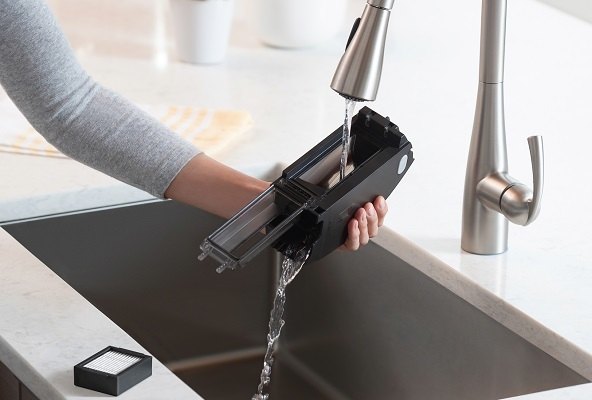
The e5’s bin is also washable. Because the motor has been moved into the body and away from the filter and collection bin, the washable bin poses no threat to the motor electronics.
Q. What kind of containment do the robots use? I heard there is a new method?
A. The primary form of containment will still be the virtual wall barriers. These dual-mode towers allow you to block off entryways, doorways and portions of rooms with a straight line infrared beam.
You can also switch it to halo mode to produce a ring of protection to surround things on the floor like pet food bowls, floor lamps and that pile of Junior’s Lego mess in the living room.
You did hear correctly that there is a new form of containment called Imprint Smart Mapping. However, this new method is only available for the i7 series. Since the 690 and e5 do not map your home, it is a useless method for these models.
What I Like About the Roomba 690
- Entry-level robot regarding cost, with high-performance value.
- Control methods are the same as the more expensive robots.
- Dirt detection helps to prevent missed spots while cleaning.
What I Like About the Roomba e5
- Better performance and longer runtime.
- A bigger collection bin for fewer trips to the garbage.
- Smarter navigation for more efficient cleanings.
In Conclusion
The two robots give you a lot to think about when making a final purchasing decision. It can be difficult to know which one to pick.
If you are trying to save money and still want the Roomba name and dependability, the 690 could be your answer. It has enough newer technology, like mobile communications, to keep you in the game while still having your floors expertly cleaned. It does have a few drawbacks though, like a small battery and collection bin and the bristle brush rollers.
If you don’t mind spending a little more, you will get a better robot. The Roomba e5 has all of the technology a mid-level robot would be expected to have, at an economy price. You will also benefit from a larger collection bin, less frequent maintenance and high-efficiency filtration.
The choice is yours, but it is easy to see that the Roomba e5 is the better machine.
Click here for all the robot vacuum deals on Amazon today.
